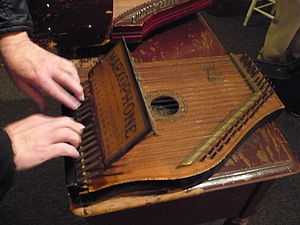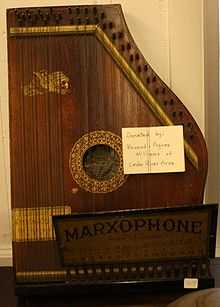Marxophone

The Marxophone is a fretless zither with two octaves of double melody strings in the key of C major (middle C to C''), and four sets of chord strings (C major, G major, F major, and D7). The player typically strums the chords with the left hand. The right hand plays the melody strings by depressing spring steel strips that hold small lead hammers over the strings. A brief stab on a metal strip bounces the hammer off a string pair to produce a single note. Holding the strip down makes the hammer bounce on the double strings, which produces a mandolin-like tremolo. The "bounce rate" is somewhat fixed, as it is based on the spring steel strip length, hammer weight, and string tension—but a player can increase the rate slightly by pressing higher on the strip, effectively moving its pivot point closer to the lead hammer.
The instrument has also been called a mandolin-guitar-zither, and a celestaphone. As well as sounding like a mandolin, the Marxophone sound is reminiscent of various types of hammered dulcimer.
Numerically coded sheet music prepared specifically for the Marxophone indicates when and in what order to play melody and chord strings. This type of music, similar to tablature, was produced for those who could not read standard notation. A rectangular piece of metal provides a backstop for the spring steel hammers, displays the name Marxophone and the patent number, and has clips that hold sheet music. It also marks the 15 keys by letter (C, D, etc.), by number (1-15) and in standard musical notation. When the instrument is moved or stored, the metal rectangle bends down, holding the keys against the strings, so the Marxophone can fit into its case—which is the size of a large briefcase.
History

The Marxophone was produced by the Marxochime Colony of New Troy, Michigan, which was in business from about 1927 to 1972. Henry Charles Marx (1875–1947), the founder of the company, obtained the original patent, #1044553, in 1912, for the mechanism the Marxophone and related celestaphone were based on. That patent was assigned to the Phonoharp Company, which he was affiliated with at the time. Marxophones and Celestaphones were produced by Phonoharp until its merger with the Oscar Schmidt Inc., in 1926. Marxophones were then produced by the merged company, International Musical Corporation of Hoboken, New Jersey. After then, Oscar Schmidt-International, successor to the International Musical Corporation, produced Marxophones through the 1950s.
Marx was one of a number of late 19th century and early 20th century musical gadget manufacturers that combined two or more instruments into one. The Hawaiian ukulele and the bowed violin or the mandolin-guitar-zither yielded instruments with names like Ukelin and Marxophone. Other inventions included the Banjolin, the Hawaii-Phone, the Mandolin-Uke, the Marxolin, the Pianoette, the Pianolin, and the Tremoloa.
Marxophones were billed as easy to play, and sold on time-purchase plans by door-to-door salesmen, and through mail-order companies like Sears-Roebuck. The 1902 Sears catalog touted the Deweylin Harp—an unrelated fretless zither available before the Marxophone—as "...the wonder of the age," and "...the greatest musical instrument that has ever been placed before the public." These mandolin-guitar-zithers purported to combine three instruments for the price of one.
Technology
Because the hammers are made of white lead, the instrument sheds small amounts of lead powder. Musicians who actively use this instrument have adopted the practice of coating the hammers in Epoxy glue, which does not affect the sound but stops the wearing away of the hammers (and prevents the poisoning of children, cats and other small creatures).
In addition to being limited to the keys of C major and A minor (and modal variants), the Marxophone is partially limited in the tempos at which it can be played. This limit is imposed by the laws of physics. The length of the piece of spring steel holding each hammer dictates the repeat rate of its striking the strings, much as the length of a pendulum controls its period—the speed at which it 'ticks' back and forth. The fixed pulse rate of the hammer strike must be a power-of-two denominated fraction of the pulse of the music, in other words an 8th, 16th, 32nd, or 64th note of the performance tempo.
A variant on the Marxophone idea is the marxoguitar or guitar-marxophone, created by Ranjit Bhatnagar. In 2010 he made a six-hammer device that could be attached to an electric guitar at the bridge, creating a Marxophone-like repeated hammer strike.
Recordings
- "Another Heart Calls" by The All-American Rejects, played by singer and bassist Tyson Ritter
- "Bullet for Ramona" by Warren Zevon
- "Alabama Song (whisky bar)" by Bertolt Brecht and Kurt Weill, played by The Doors keyboardist Ray Manzarek
- "Someone's in the Wolf" by Queens of the Stone Age, played by Alain Johannes (misspelled as "Markxophone" in the liner notes)
- Numerous recordings by projects associated with Stephin Merritt.
- "Run, Pig, Run" by Queens of the Stone Age, played by Alain Johannes (misspelled as "Marxaphone" in the Era Vulgaris liner notes)
- "Up in Hell" by Desert sessions in The Desert Sessions VII & VIII, played by Fred Drake
- "Anna Molly" and "Leech" by Incubus
- "Am I Awake?" by They Might Be Giants (John Linnell postulates it to be the first known recorded song to feature a backwards Marxophone)
- "I Feel Beautiful" by Robyn Hitchcock
- "Annan Water" by The Decemberists
- "Sour Times" by Portishead (band)
- "Combinations" by Eisley
- "Tymps (The Sick in the Head Song)" by Fiona Apple
- "I'm On Fire" (originally by Bruce Springsteen), covered by Bat for Lashes
- "Glass" by Bat For Lashes from the album Two Suns, played on the recorded version by Ben Christophers
- "Daniel" by Bat for Lashes, used during live performances
- "Jingle Bells" by Roy Zimmerman
- "He Forgot that It Was Sunday" by John Prine
- "When Girls Get Together" by The Beach Boys
- "Guys Like Me" and "The Moth" from Aimee Mann's Lost in Space (album)
- "The Box" by Orbital
- "Autoharp" by Hooverphonic
- John Sebastian of '60s rock group The Lovin' Spoonful played the Marxophone for the song "She is Still a Mystery" on their 1968 album Everything Playing after receiving it from someone who had mistaken it for an autoharp.
- "You've Ruined Me" by Norah Jones in The Fall (album) played by Zac Rae.
- "Signed Fictitious" by Vernon Reid in his 1996 album Mistaken Identity played by Brian Cullman.
- "Strange Perfumes" by Laurie Anderson in her 2010 album "Homeland" played by Rob Burger.
- "Helplessness Blues" by Fleet Foxes.
- "Amarillo Sleeps On My Pillow" by Fair To Midland in their album "Arrows & Anchors".
- A Marxophone was also used on the soundtrack for the video game Red Dead Redemption.[1]
- "One-Armed Bandit" by Jaga Jazzist.
See also
Notes
- ↑ Video: Behind the Scenes of the Red Dead Redemption Soundtrack. Marxophone shown at 2:47. Rockstar Games - Red Dead Redemption videos (or on YouTube)